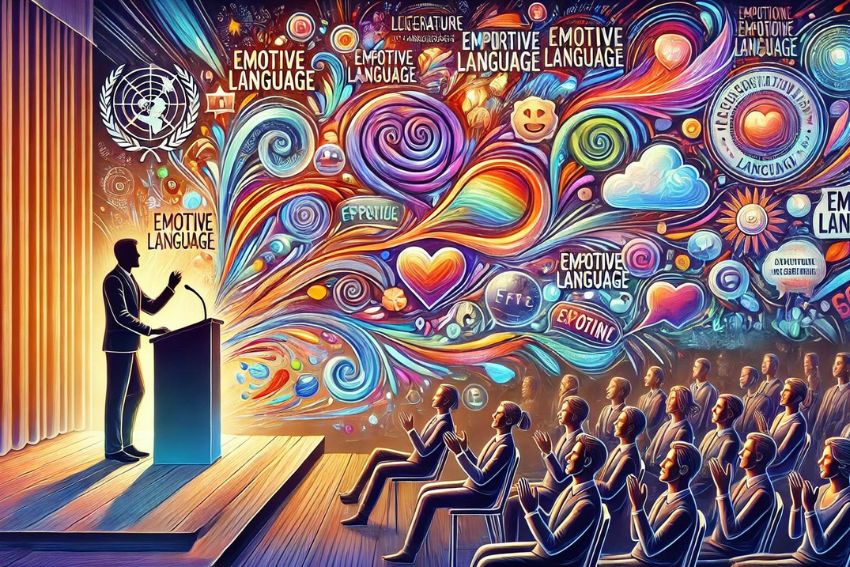Emotive language is a powerful tool used to evoke emotional responses and engage audiences. It transforms simple messages, through the strategic use of words, into powerful narratives in literature, speeches, ads, or just conversational talks. This blog post is therefore aimed at explaining all the varying aspects related to emotive language and areas of its application relevant to the betterment of communication.

Understanding and using the language of emotion will allow a writer or speaker to craft a much more powerful message, one that is persuasive in an extraordinary way and powerfully resonates with the intended audience.
Understanding Emotive Language
Emotive language is word-use that is specially deployed to arouse audiences’ feelings. This powerful tool can work wonders within literature and rhetorical communication alike by bringing home personal, strong messages because of the tugging of heartstrings with a target audience.
Emotive language possesses the ability that the words, picked carefully, may evoke feelings of great strength. It often works to convince one through the stirring of an emotional response and subsequently closer engagement with the message or plight being put across. This approach occurs in great frequency within literature, speeches, advertisements, and everyday talking.
Exploring the Mechanics Behind Emotive Language
At its core, emotive language works by tapping into the emotional centres of the brain. This can be achieved through various linguistic techniques, such as the use of vivid imagery, strong adjectives, and evocative verbs.
- Imagery – Descriptive language that paints a vivid picture can make the reader feel as though they are experiencing the event themselves. For example, describing a scene as “a desolate, windswept wasteland” conjures a strong visual image and evokes feelings of emptiness and isolation.
- Strong Adjectives – Words like “heartbreaking” “breathtaking” and “terrifying” immediately convey strong emotions. For example, “The news was heartbreaking” communicates the intensity of the situation more effectively than “The news was sad.“
- Evocative Verbs – Action words such as “shattered” “embraced” and “celebrated” can dramatically alter the emotional tone of a sentence. For instance, “She shattered his dreams” versus “She broke his dreams.”
What is an Example of the Emotive Function of Language?
An example of the emotive function of language can be seen in how people express their feelings and emotions directly through their words. This function focuses on the speaker’s emotions and attitudes, aiming to convey their internal state to the listener. Here’s a detailed example:
Emotive Function in Personal Expression
Imagine a person writing a heartfelt letter to a close friend who is moving away. The language used will be charged with emotions, aiming to express the depth of their feelings about the situation.
Example:
"Dear Sarah,
I can’t believe you’re leaving. It breaks my heart to think that you won’t be just around the corner anymore. We’ve shared so many incredible moments, and the thought of not seeing your smile every day fills me with sadness. You’ve been my rock, my confidant, and my partner in all our crazy adventures. The memories we’ve made together are priceless, and I’ll cherish them forever. I’m so proud of you and excited for your new journey, but I’m also incredibly sad to see you go. Please keep in touch and remember that no matter where you are, you’ll always have a special place in my heart.
With all my love, Emily"
In this example, the emotive function of language is clearly demonstrated through the use of words and phrases that express deep affection, sadness, pride, and nostalgia. The language aims to convey the writer’s emotional state and create an emotional response in the reader.
Real-World Applications of Emotive Language

Emotive language is used extensively across various forms of communication. Here are a few examples:
- Literature – Authors use emotive language to create emotional connections between their characters and readers. For example, in Charles Dickens’ “A Tale of Two Cities,” the phrase “It was the best of times, it was the worst of times” evokes a complex emotional landscape.
- Advertising – Marketers use emotive language to evoke desires and fears, encouraging consumers to buy products. An ad might say, “Transform your skin with our revolutionary cream” which evokes hope and aspiration.
- Speeches – In the world of sports, coaches and team leaders often use emotive language to inspire and motivate their teams. For instance, a coach might say, “This is our moment to shine, to fight with every ounce of strength, and to leave everything on the field” stirring feelings of determination and unity.
emotive language plays a powerful role in shaping the way we connect with content, whether it’s literature, advertising, or speeches. By tapping into emotions, this language style influences how we perceive and respond to messages. These emotive language examples highlight its effectiveness in stirring emotions, motivating action, and creating memorable experiences in various forms of communication.
Emotive Words and Emotive Adverbs – The Power of Language to Evoke Emotions
Language is a powerful tool that shapes our perceptions, influences our decisions, and connects us to others. Among the various elements of language, emotive words and emotive adverbs hold a unique place. These linguistic devices can evoke strong emotions, making communication more impactful and memorable. In this blog, we will explore the significance of emotive words and adverbs, their usage, and their role in effective communication.
What are Emotive Words?
Emotive words are words that evoke specific emotions in the reader or listener. They are carefully chosen to elicit feelings such as happiness, sadness, anger, fear, or excitement. These words go beyond mere description, tapping into the emotional responses of the audience. For example:
- Love: A word that conjures warmth, affection, and tenderness.
- Hate: A term that sparks feelings of anger, resentment, and hostility.
- Joy: Evokes happiness, pleasure, and delight.
- Fear: Instills a sense of dread, anxiety, and apprehension.
- Disgust: Causes revulsion, loathing, and aversion.
Using emotive words strategically can enhance the emotional impact of your writing or speech, making it more engaging and persuasive.
10 Emotive Words

Emotive words are powerful tools used to evoke strong feelings in a reader or listener, turning ordinary statements into emotionally charged messages. These words can express happiness, sadness, anger, or fear, helping the writer or speaker influence their audience’s emotions. Here are 10 common emotive words that can make your writing or speech more impactful:
- Heartbroken – Conveys deep sadness and grief.
- Elated – Expresses extreme happiness and joy.
- Terrified – Instills a sense of fear or anxiety.
- Furious – Describes intense anger and frustration.
- Compassionate – Evokes feelings of empathy and kindness.
- Devastated – Reflects complete emotional destruction or sorrow.
- Awe-inspiring – Suggests wonder and admiration.
- Disgusted – Indicates strong aversion or disapproval.
- Triumphant – Highlights the joy of victory or achievement.
- Lonely – Creates a sense of isolation and sadness.
Using these emotive words in your writing helps to communicate more than just facts—it taps into the reader’s emotions, making your message resonate on a deeper level. Whether you’re writing an essay, a speech, or even an advertisement, strategically incorporating emotive words can turn an ordinary piece into something memorable and moving.
Role of Emotive Adverbs
Emotive adverbs modify verbs, adjectives, or other adverbs, adding an emotional layer to the action or description. They intensify the emotional experience conveyed by the sentence. For instance:
- Passionately: As in “She spoke passionately about her cause” where the adverb intensifies the speaker’s fervour.
- Desperately: As in “He desperately tried to reach her” highlighting the urgency and intensity of his efforts.
- Joyfully: As in “They danced joyfully under the stars” enhancing the sense of happiness and celebration.
- Sadly: As in “She looked sadly at the old photographs” adding a layer of melancholy to her gaze.
- Angrily: As in “He slammed the door angrily” conveying the force and emotion behind his action.
Emotive adverbs, like emotive words, are powerful tools that can shape the reader’s or listener’s emotional response, adding depth and resonance to your message.
How to Use Emotive Words and Adverbs Effectively
- Know Your Audience – Understand the emotions you want to evoke in your audience. Different contexts and audiences may require different emotive words and adverbs.
- Be Authentic – Use emotive language that genuinely reflects your feelings and intentions. Authenticity enhances credibility and connection with your audience.
- Avoid Overuse – While emotive words and adverbs are powerful, overusing them can diminish their impact and make your writing seem melodramatic or insincere. Use them sparingly and strategically.
- Combine with Strong Imagery – Pair emotive language with vivid imagery to create a more immersive and emotionally resonant experience for your audience.
- Edit Ruthlessly – During revision, ensure that your emotive language enhances your message without overshadowing it. Remove any emotive words or adverbs that do not add significant value.
What Are the 27 Basic Emotions?
Understanding the spectrum of human emotions is essential for effective communication. Emotions influence our thoughts, behaviours, and interactions with others. Researchers at University of California, Berkeley identified 27 categories of emotion that universally resonate across cultures:
- Admiration
- Adoration
- Aesthetic Appreciation
- Amusement
- Anxiety
- Awe
- Awkwardness
- Boredom
- Calmness
- Confusion
- Craving
- Disgust
- Empathetic Pain
- Entrancement
- Envy
- Excitement
- Fear
- Horror
- Interest
- Joy
- Nostalgia
- Relief
- Romance
- Sadness
- Satisfaction
- Sexual Desire
- Surprise
These emotions form the bedrock of our emotional experiences, shaping how we perceive and engage with the world.
Emotive language plays a crucial role in expressing and evoking these basic emotions. By carefully selecting words and phrases that resonate emotionally, we can create powerful connections with our audience. For instance, describing a scene with words like “awe-inspiring” or “heart-wrenching” immediately triggers specific emotional responses, enhancing the impact of our message. Understanding and utilising emotive language effectively can transform mundane communication into a compelling and relatable narrative, making our interactions more profound and memorable.
To Sum Up
Emotive language is one of the most powerful tools that can completely change the face of your communication to make it more engaging, persuasive, and memorable. Knowing and using words emotionally will help you connect at a deeper level with any audience for a piece of literature, political speech, or simply some really effective ad copy.
In educational contexts, particularly in A-Level and GCSE studies, the understanding and use of emotive language can significantly enhance both written and oral communication skills. For GCSE English, students learn to identify and analyse emotive language in texts, understanding its impact and effectiveness. At the A-Level, students delve deeper into the strategic use of emotive language, developing their ability to employ it in persuasive essays, debates, and presentations. This correlation highlights the importance of emotive language not only in academic success but also in everyday communication.
By mastering the use of emotive language, you can ensure your message resonates emotionally, persuading and captivating your audience effectively. Remember, while it’s a powerful tool, it’s essential to use it ethically, balancing emotional appeal with logical reasoning to maintain credibility and trust.
For those seeking additional support in mastering emotive language and other critical skills, private tutors on Edumentors can provide personalised guidance. Tutors from top UK universities are available to help students develop their writing and analytical abilities, ensuring they excel in both GCSE and A-Level studies. Whether you need help understanding the nuances of emotive language or improving your overall communication skills, Edumentors offers expert assistance tailored to your learning needs.
FAQ’s
What are 5 examples of Emotive Language?
Emotive language is used to evoke emotions and create a strong connection with the audience. Here are five examples:
- Heartbreaking – Used to describe a situation that causes deep sadness or grief.
- Example: “The images of the devastated city were truly heartbreaking.”
- Inspiring – Used to describe something that evokes motivation or admiration.
- Example: “Her story of overcoming adversity is incredibly inspiring.”
- Outraged – Used to express strong feelings of anger or indignation.
- Example: “The community was outraged by the unfair decision.”
- Terrified – Used to evoke a sense of extreme fear.
- Example: “She was terrified by the sudden appearance of the storm.”
- Blissful – Used to convey a state of perfect happiness or joy.
- Example: “They spent a blissful day by the seaside, without a care in the world.”
What is an example of Emotive Language for Grade 10?
In Grade 10, students learn to use emotive language to evoke strong emotions in their writing. For example: “The abandoned puppy whimpered alone in the cold, its tiny frame shivering with fear and hunger.” This sentence uses emotive language by choosing words like “abandoned,” “whimpered,” and “shivering” to create feelings of sympathy and concern in the reader. At this level, students practice identifying and using such language in persuasive essays, narratives, and literature analysis to enhance the emotional depth of their writing.
What is an example of the Emotive Function of language?
The emotive function of language is used to express the speaker’s emotions, feelings, or attitudes. A common example can be found in speeches or everyday interactions. For instance, a statement like “I am so thrilled to see you!” showcases the speaker’s excitement and positive emotions. Another example could be a phrase like “I can’t believe this is happening, it’s devastating,” which conveys sadness or frustration. In both examples, the primary goal is to communicate the speaker’s emotions, rather than convey factual information.








